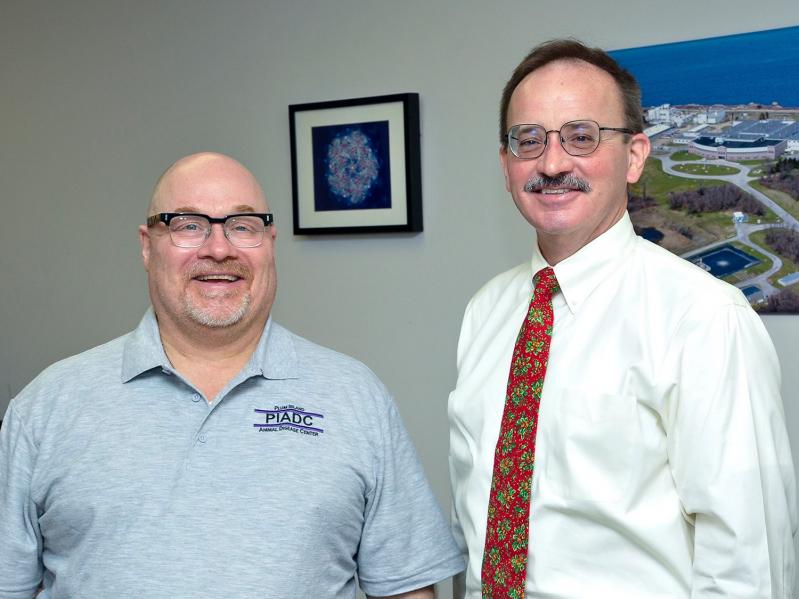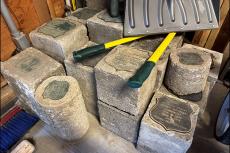It was a cold, wet spring on Plum Island. Scientists and administrators there say that both ticks and seals have been plentiful, and a pair of nesting bald eagles was again sighted in the wetlands. The trees are in full bloom now — finally — and at the Plum Island Animal Disease Center, big changes are on the horizon.
In December, the United States Department of Homeland Security reached substantial completion of its new National Bio and Agro-Defense Facility in Manhattan, Kansas. The U.S. Department of Agriculture will officially kick off its operations there with a ribbon-cutting ceremony on Wednesday. This signals the start of what comes next: a slow and careful decommissioning process at Plum Island, which for the last 69 years has been devising ways to identify and treat “transboundary animal diseases,” preventing foreign viruses like foot-and-mouth disease and African swine fever from impacting American livestock, meat, and dairy industries.
It will still be a few years before the center’s full decommissioning is complete. Dr. Tod Companion, the director of the Plum Island Animal Disease Center and an immunologist by training, and John M. Searing, the deputy center director, program manager, and an engineer, explained in an interview on May 4 that Plum Island will still be a fully functioning laboratory until at least December 2024. However, the new Kansas facility has begun “running systems and collecting data,” a process that is expected to be finished in June, and multiple Plum Island employees have already transferred to Kansas to move the process along.
Plum Island’s closure “is certain but not imminent,” Dr. Companion said, noting that “we have to keep the diagnostic test capabilities online” until the new Kansas facility is fully operational. In particular, scientists are watching a current outbreak of African swine fever in the Dominican Republic. “We’re very concerned,” he said. “We have a plan to ramp down, but we haven’t gotten the signal yet from the U.S.D.A. to go.”
“Nothing will leave our primary containment labs,” he continued. “Everything that comes out will be autoclaved” — meaning destroyed using pressurized steam — “and sterilized.”
“They have brand-new, state-of-the-art equipment” in Kansas, Mr. Searing added. “We have state-of-the-art equipment here, but it’s difficult to bring out . . . so it’s really just a movement of our fabulous staff out there to start the work.”
After the National Bio and Agro-Defense Facility works up to its ultimate laboratory certification, Plum Island will stand down. “That’s not a trivial task,” Mr. Searing said. “It will take a few years to do that.”
As decommissioning plans take shape, the future of Plum Island itself is wide open. Once slated to be sold at auction — an option that’s no longer formally on the table — environmental advocates and elected officials have been lobbying for several years for preservation. The 822-acre island is nearly untouched by development, save for the research center and support buildings, the lighthouse, its Orient-to-Plum Island ferry terminals, and the old Fort Terry, a key military facility in multiple armed conflicts over centuries of American history.
Hundreds of species of plants and animals, including some rare and protected species, thrive on Plum Island. And, as proven by scientist-divers, the waters surrounding it are pristine. “There wasn’t any trash,” Dr. Matthew Schlesinger, chief zoologist with the New York Natural Heritage Program, which joined InnerSpace Scientific Diving in studying the marine ecosystem, told The Star in April 2022. “That’s rare for Long Island, to have an underwater ecosystem where you’re not finding direct evidence of humans either being there or dropping something nearby.”
On May 5, Representative Nick LaLota of New York’s First Congressional District sent a letter to President Joe Biden asking him to voice his support for the Plum Island National Monument Act, which Mr. LaLota introduced in March, or to use his presidential powers under the Antiquities Act of 1906 to outright declare the island a national monument.
“I strongly urge you to designate Plum Island as a national monument to protect its cultural history and natural resources,” Mr. LaLota wrote in his letter to the president. “If action is taken, Plum Island can be used for recreation activities for the people of New York and Connecticut, and the valuable biodiversity on the island can be federally preserved.”
His proposed legislation has picked up a Democratic co-sponsor, Representative Joe Courtney of Connecticut, and is currently being reviewed by the House Subcommittee on Federal Land.
“We’re committed to leaving Plum Island in the best possible fashion for whoever the next owner is,” Mr. Searing said, “so that it can be used in the fashion that the public officials think is best suited for everyone locally and maybe even for the United States.”
Even after all these years, Plum Island officials still find themselves occasionally having to counter misinformation and suspicion. The distinction is that it is a secure facility, not a secret facility. On a website dedicated to the facts, the Department of Homeland Security says no classified research is done there; the scientists frequently “submit research for peer-reviewed publication in national and international scientific journals, as well as present their research at scientific conferences.” You can even find satellite images of Plum Island’s buildings on Google Maps.
Over the last seven decades, Dr. Companion and Mr. Searing said, scientists there have developed two dozen types of diagnostic tests, two vaccines for foot-and-mouth disease, and multiple vaccine prototypes for African swine fever. The center has trained thousands of veterinarians and made concrete progress on the “deep science” of immunology, pathology, and virology.
“The history of Plum Island is the history of biosafety. . . . It has been serving as a frontline defense for the country since the 1800s,” Dr. Companion said. “This has always been the people’s island, but we’ve been using it to protect them. . . . We’re very proud of the work we have done here.”




